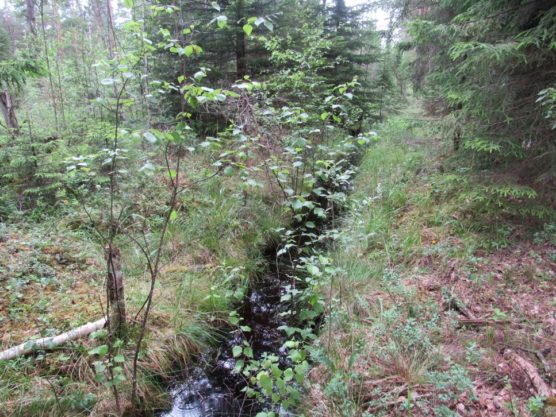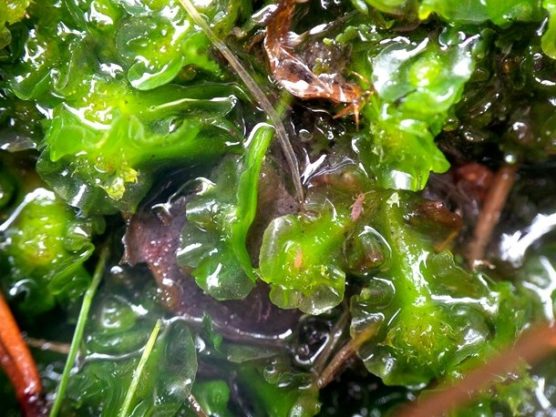In the beginning of 2017, elaboration of site management plans for two Latvian project areas, Baltezers Mire Nature Reserve and Augstroze Nature Reserve, was commenced. The management plans are necessary to substantiate appropriate conservation and restoration actions, including peatland restoration proposed within the LIFE Peat Restore project.
In 18 August 2017, the first steering group meeting for the management plan of Baltezers Mire Nature Reserve was held. The coordinator of the plan G. Freimane and experts involved presented the first results of field surveys and suggestions for problem solutions, e.g. location of dams on drainage ditches, solutions for beaver control and options for recreational activities in the reserve. The mire and forest habitats were surveyed by L. Strazdiņa, the Baltezers Lake – by L. Grīnberga, birds – by H. Hofmanis, and hydrology – by O. Aleksāns.
Steering group of the site management plan. Photo: Māra Pakalne.
According to the field survey results, seven habitat types listed in the Annex I of the Habitats Directive are present in the area: Oligotrophic to mesotrophic standing waters with vegetation of the Littorelletea uniflorae and/or of the Isoëto-Nanojuncetea (3130), Transition mires and quaking bogs (7140), Western Taïga (9010*), Fennoscandian helni- boreal natural old broad-leaved deciduous forest (9020*), Fennoscandian herb-rich forests with Picea abies (9050), Bog woodlands (91D0*), and Alluvial forests with Alnus glutinosa and Fraxinus excelsior (91E0*). The most important habitats for the particular area are transition mire and the mesotrophic Baltezezers Lake.
One of the ditches draining the mire. Photo: Agnese Priede.
Numerous rare, protected plant species were found, e.g. Ophyris insectifera (one of only three localities in Latvia), Moerckia hibernica (new record for Latvia, one of 3–4 localities in Latvia), Galium triflorum (one of very few localities in the country), Isoëtes lacustris (one of two localities in Western Latvia). The transition mire and adjacent bog woodland are rich in orchid species (Epipactis palustris, Dactylorhiza fuchsii, Dactylorhiza maculata, Platanthera bifolia). Also several protected bird species were recorded, e.g. Bonasa bonasia, Tetrao tetrix, Dryocopus martius, Ficedula parva, Glaucidium passerinum, etc.
Moerckia hibernica – a very rare moss species in mires, new record in Baltezers Mire. Photo: Līga Strazdiņa.
Around one third of the reserve area lies on peat soils. Though still important for biodiversity, the mire and adjacent forests are heavily drained. The earliest drainage works were carried out in the first decades of the 20th century, whereas the functioning ditch network that causes most of deteriorating effects on the mire was created in the 1960s. Due to drainage, the open mire area has decreased by at least one half.
Detailed studies of the mire hydrology are still ongoing. In order to prepare the hydrological restoration plan and technical design, topographical levelling has been carried out, and digital surface model data and field survey data are used. In the nearest future, the wells for hydrological monitoring will be placed. Together with monitoring of vegetation and greenhouse gas fluxes, the hydrological monitoring will allow assessing the outcome of the peatland restoration.
Ophrys insectifera – one of three species localities in Latvia occur in Baltezers Mire. Photo: Agnese Priede.
Beaver activity has caused paludification in fairly large areas in the former forest clearcuts. Beaver activity is the reason also for water level fluctuations in the mesotrophic lake causing increased nutrient leaching, thus gradually leading to deterioration of the ecological quality of the lake and posing risk to the very rare aquatic macrophyte Isoëtes lacustris. Though the beaver activity may contribute to recovery of drainage-affected peatland habitats, it has also undesirable side effects, and, most probably, should be controlled.
The experts continue working on the site management plan by summarizing the field survey data and elaboration of action plan for hydrological restoration, including selecting sites for ditch blocking, and other activities targeted at conservation of the species and habitats.






